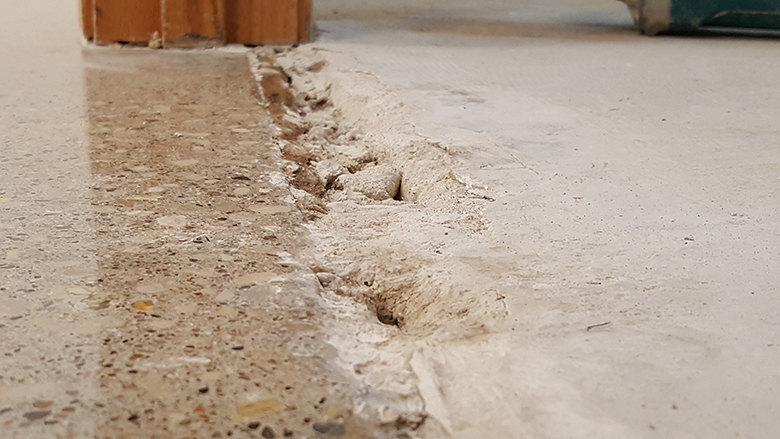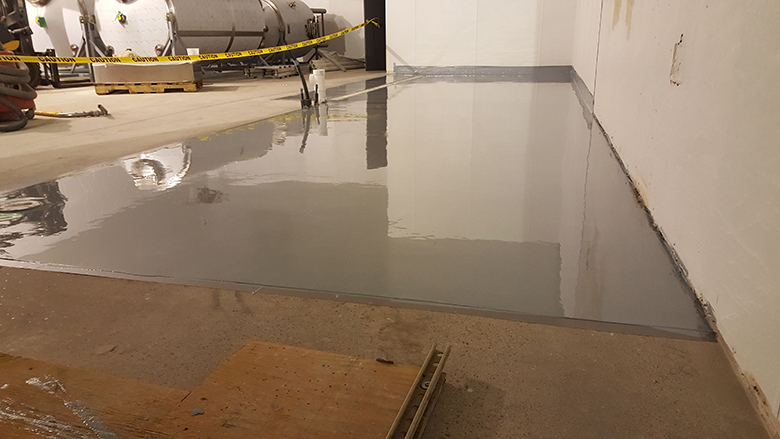If you’ve recently pulled up your carpet to find the concrete beneath it covered in adhesive, you may wonder if it’s possible to restore your concrete floors. This blog is for you!
Concrete floors are one of the most beautiful flooring options available, and they look great in everything from hip restaurants to large-scale industrial operations. They’re highly customizable, too, which means you can match just about any architectural design or style.
But if you’ve been thinking about refinishing the concrete floors in your home or business, you may be hesitant because of glue damage from previous flooring, such as carpet. Let us settle your concerns.
You might be surprised to learn that glue does not mark the end of your concrete floors!
Our expert floor specialists at ACT Restoration in Andover, Minnesota, use our concrete preparation methods to remove glue and repair the concrete surface, making it like new once more.
Here’s how it works!
Changes in Flooring Trends
If you’ve been considering removing your carpet to reveal the concrete floor below, you’re in good company. But before we explore how much things have changed, let’s step back in history for a moment.
There once was a time when wall-to-wall carpet was the standard for modern homes and buildings. Ahhh yes, who could forget the 1970s? (You had to be there!)
When carpet installers laid their original carpet down against the concrete floors, no one was thinking about the condition the concrete would be in if it was removed one day. It was common for carpet installers to use adhesive heavily over the entire floor to ensure the carpet was firmly attached to the subfloor beneath it.
Even if the homeowners (or commercial businesses) of the day decided to remove the carpet and go with another flooring option, it would have most likely been to install linoleum or hardwood flooring.
But polished concrete floors have come a long way over the years, and today’s concrete floors are inviting and elegant flooring solutions that easily rival other types of flooring.
Types of Concrete Floor Damage
Concrete floors are becoming a bigger trend than ever thanks to their incredible durability and decorative versatility.
But it wasn’t always this way.
For many decades, home and business owners did everything they could to hide their concrete floors, not realizing the beautiful potential of their concrete flooring.
The application of many flooring options like tile meant using a powerful adhesive. When business or homeowners decide to refinish these concrete floors, they often find these floors are covered with ugly adhesive that can be very difficult to remove.
Here are three of the most common adhesives we find:
Other signs of damage to concrete floors include:
- Spalling: concrete broken into smaller pieces
- Structural breaks: significant cracks
- Dull surface: caused by wear and tear
- Broken joints: cause by expanding and contracting floors
- Uneven floor: cause by changed underneath the floor or too much weight

It is entirely possible to upgrade your concrete floors through restoration processes. Even when concrete floors are well-maintained, they can dull and crack over time.
However, their extreme durability and ease of restoration make them a popular choice for homes and businesses.
Removing Adhesives From Concrete Floors
The floor specialists at ACT Restoration are experts in preparing concrete floors. That means not only are we capable of handling glues, epoxies, and other adhesives, but we have the experience to boot.
We begin by scraping off every bit of adhesive possible using our specialized equipment. Each adhesive requires a different method of removal, and we’re well versed in each one.
Concrete Floor Resurfacing for Carpet Adhesive
To resurface floors with carpet adhesive and other problems that result from years of being covered by heavily padded carpet, a floor refinishing team starts by cleaning the floors. This helps them get a sense of what they’re working with and preps the floor for the wet grind process.
Next, they professionally remove the residue using the wet grind method. Unlike a dry grind method, which kicks up significant dirt and debris, the wet grind method works by creating a slurry across the surface of your concrete for dust-free repair.
Finally, we’ll finish your floor with the level of shine or stain you’ve chosen.
In addition to carpet adhesive, the wet grind method can repair these flaws:
- Chips
- Cracks
- Scratches
- Bumps
Concrete Floor Finishing Options
If you want something more than a gray concrete floor, you’re in luck! There are many colorful options to finish your concrete floors that will make them beautiful and timeless.
Concrete dyes and stains are used to bring color to your concrete floors. With many color options to choose from, you can customize your concrete floors to match whatever aesthetic you’re going for.
Another method of concrete floor finishing is epoxy. In conjunction with a great concrete floor, epoxy can save a lot of money on finishing while making your floor look great. There are several options for epoxy flooring, such as decorative, metallic, reflective, quartz, and paint chip.

Epoxy is quick to install and reduces wear and tear on your floors. No matter which epoxy style you choose, you’ll get a wonderful concrete floor that will stand up to wear and tear.
Call Our Minnesota Floor Refinishing Experts
If you’ve been dreaming of a concrete floor staining project for your home but you’re concerned that decades of shag carpet has made it an impossibility, give us a call. Our Minnesota concrete floor resurfacing pros at ACT Restoration are experienced in restoring a wide range of issues with the concrete subfloor in Andover homes.
Stop by our digital portfolio to check out examples of our past work and get inspiration for your concrete floor restoration project, or check out the many stains available for your floors.
Call us at 612-750-5360 or contact us on the web for your completely free estimate today.